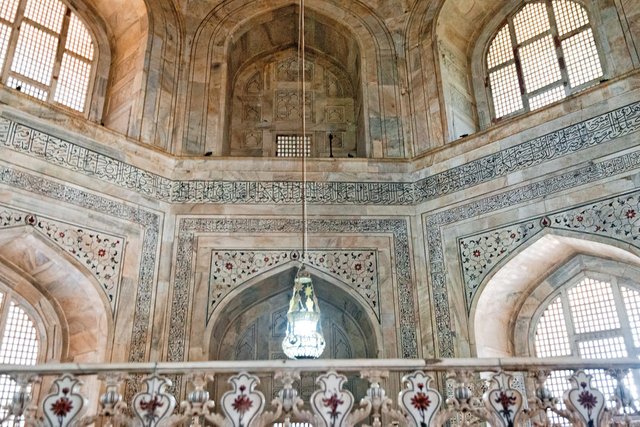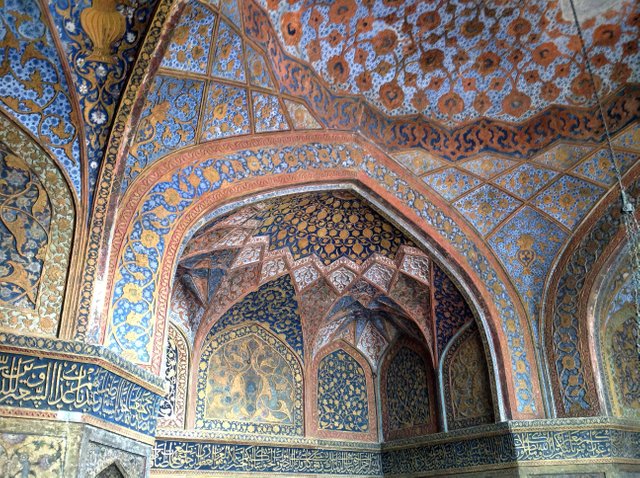TAJ MAHAL -Curosity to view ..the amazing architecture.
Also known as Rauza-i-Munauwara or Rauza-i-Muqqadas or Rauza-i-Mutahhara. The mausoleum dominates the entire Taj complex: the architectural effect is that of a strictly ordered progression of elements towards the overwhelming climax of the white marble building. The mausoleum is set at the northern end of the main axis of vast oblong walled complex which descends in hardly noticeable terraced steps towards the river Yamuna. The overall composition is formed of two major components: the mausoleum and its garden, and two subsidiary courtyard complexes to the south.
THE TOMB
The central focus of the complex is the tomb. This large, white marble structure stands on a square plinth and consists of a symmetrical building with an iwan (an arch-shaped doorway) topped by a large dome and finial. Like most Mughal tombs, the basic elements are Persian in origin. The base structure is essentially a large, multi-chambered cube with chamfered corners, forming an unequal octagon that is approximately 180 feet on each of the four long sides. On each of these sides, a massive pishtaq, or vaulted archway, frames the iwan with two similarly shaped, arched balconies stacked on either side. This motif of stacked pishtaqs is replicated on the chamfered corner areas, making the design completely symmetrical on all sides of the building. Four minarets frame the tomb, one at each corner of the plinth facing the chamfered corners. The main chamber houses the false sarcophagi of Mumtaz Mahal and Shah Jahan; the actual graves are at a lower level.
THE SCREEN AND THE CENOTAPHS
The naturalistic decoration of the interior culminates in the central ensemble of the cenotaphs of Mumtaz and Shah Jahan and the screen that surrounds them. It attracts all visitors today with its spectacular flowers and plants inlaid in semi-precious stones.
The perforated marble screen (mahjar-i mushabbak) was set up in 1643 to replace the original one of enamelled gold made by the goldsmith and poet Bibadal Khan on the occasion of the second anniversary of Mumtaz Mahal's death in 1633, which was obviously deemed too precious. It took ten years to make and cost 50,000 rupees, less than one-tenth of the cost of the gold screen. Since 1994-1995 AD it has been protected from the hands of visitors by an ungainly aluminium grille in a wooden frame.
The screen is octagonal, reflecting on a smaller scale the octagon of the surrounding hall and intensifying the paradisiacal symbolism of the number eight. Overall arrangement and detail follow the principles of Shahjahani system. Each side of the octagon is divided into three by marble frames. The corners are fortified by posts ending in kalasha finials (globes surmounted by a pointed element), an adaptation of a feature of older Indian architecture. The frames are filled with jalis, in which elegantly and intricately wrought plant elements are composed around a central axis - the only instance in the Taj Mahal where jalis are formed of organic plant arabesques rather than geometric forms.
The Indian jali tradition is here brought to one of its highest points. The screen is topped with ornamental crenellations, kanguras, consisting of vase-shaped elements alternating with openwork formed of volutes of acanthus leaves, crowned at their juncture by small vase elements. The entrance arch in the centre of the south side and a corresponding closed arch opposite it in the centre of the north side rise above the screen; they have semicircular heads lined by a moulding terminating in hanging acanthus buds.
THE DECORATION OF THE UPPER CENOTAPH OF _
MUMTAZ MAHAL:
The main decoration consists of inlaid Qur'anic inscriptions. Naturalistic plums are confined to the platform, where two types alternate, between borders of hanging blossoms: one has asymmetrically arranged erect funnel-shaped calyxes and buds, the other a perfectly symmetrical arrangement of seven smaller blossoms and buds; both seem to be inspired by lilies and the upper surface of the platform has a framed flowery scrollwork pattern. Inscribed on the top and the sides of the block are Quran'ic verses in formal Sulus script; their common theme is to comfort the soul (of Mumtaz) with the prospect of Paradise.
The epitaph reads: ‘The illumined grave of Arjumand Bano Begam, entided Mumtaz Mahal, who died in the year 1631’.

✅ @auditors-thought, I gave you an upvote on your post! Please give me a follow and I will give you a follow in return and possible future votes!
Thank you in advance!
Hi! I am a robot. I just upvoted you! I found similar content that readers might be interested in:
https://www.tajmahal.gov.in/interior_decoration.html
Congratulations @auditors-thought! You have completed the following achievement on Steemit and have been rewarded with new badge(s) :
Click on the badge to view your Board of Honor.
If you no longer want to receive notifications, reply to this comment with the word
STOPDo not miss the last post from @steemitboard:
SteemitBoard World Cup Contest - Russia vs Croatia
Participate in the SteemitBoard World Cup Contest!
Collect World Cup badges and win free SBD
Support the Gold Sponsors of the contest: @good-karma and @lukestokes
Congratulations @auditors-thought! You have completed the following achievement on Steemit and have been rewarded with new badge(s) :
Click on the badge to view your Board of Honor.
If you no longer want to receive notifications, reply to this comment with the word
STOPDo not miss the last post from @steemitboard:
SteemitBoard World Cup Contest - The semi-finals are coming. Be ready!
Participate in the SteemitBoard World Cup Contest!
Collect World Cup badges and win free SBD
Support the Gold Sponsors of the contest: @good-karma and @lukestokes